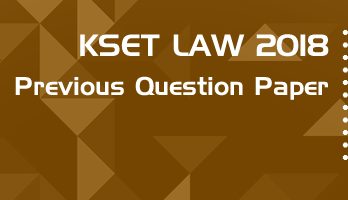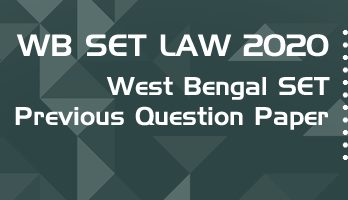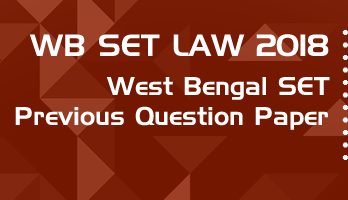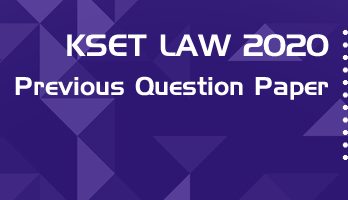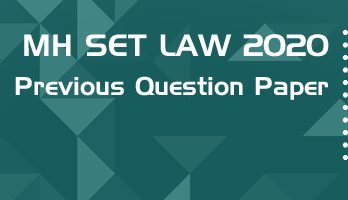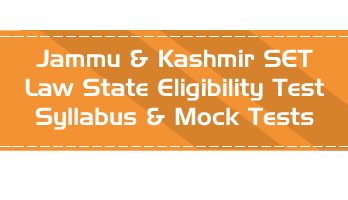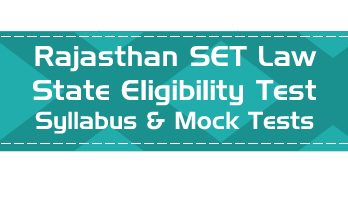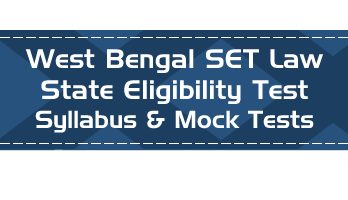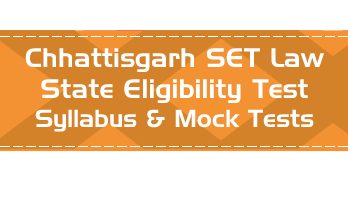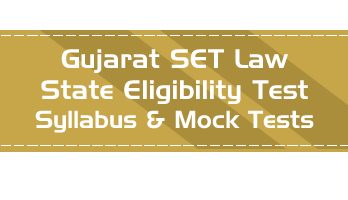- Based on latest Maharashtra State Eligibility Test Law Paper II Syllabus
- Law Subjects Overview Material covering important topics and concepts - 650 page PDF Book
- 50 Full Length Mock Tests - New Pattern Paper II, with 100 questions each
- 50 Mini Practice Mock tests - with 25 questions each
- Unlimited Practice - New Questions in every mock test with every attempt
- Answer choices of all questions shuffled randomly for better practice
- Database of over 9500 MCQs covering the entire syllabus
- Includes new comprehension based questions
- Questions & Answer Choices randomly shuffled in every attempt for better practice
- Accessible 24 x 7 via Smart-Phone browsers and Desktops
"Just wanted to let you know that I have cleared JRF with 99.99th percentile. Thank you for all your help and support that made it possible. " - Kanchan Yadav
"Thank you so much for the UGC NET test series. I finally qualified the exam. It was possible because of the mock test series provided by your team." - Robin Jaiswal
This is the full previous question paper from MH-SET 2019 Paper II Law Subject, i.e. the Maharashtra State Eligibility Test examination conducted in 2019 for eligibility for Assistant Professor posts in Maharashtra & Goa.
The official answer key for this question paper, along with other all recent previous papers and 100 Mock tests / model papers with unlimited practice are included in our online MHSET Law Online Practice Pack.
1# The Principle/s of Natural Law Theory are :
A# Universal order governing all men
B# Inalienable rights of an individual
C# Both, Universal order governing all men and Inalienable rights of an individual
D# None of the choices
2# Kelsen’s Grundnorm is similar to Prof. H.L.A. Hart’s rule :
A# Rule of adjudication
B# Rule of change
C# Rule of recognition
D# None of the choices
3# According to ______, law is found, not made.
A# Roscoe Pound
B# Prof. H.L.A. Hart
C# John Austin
D# Savigny
4# The history of the Natural Law is a tale of the search of mankind for absolute justice and its failure. Who said this ?
A# Friedmann
B# Dias
C# Dicey
D# Holmes
5# The Jural Correlative of ‘Power’ is :
A# Liability
B# Duty
C# Disability
D# Immunity
6# Thomas Nagel claims, people are in a _______ only if they belong to the same state.
A# Natural relationship
B# Human relationship
C# Contractual relationship
D# Justice relationship
7# Bracket theory of corporate personality is also known as :
A# Concession theory
B# Symbolist theory
C# Purpose theory
D# Fiction theory
8# Intellectual Property Right is an example of :
A# Incorporeal ownership
B# Beneficial ownership
C# Equitable ownership
D# Contingent ownership
9# Which of the following is not in Roscoe Pound’s Scheme of Interests ?
A# Individual Interests
B# Public Interests
C# National Interests
D# Social Interests
10# The book titled ‘The Enforcement of Morals’ was authored by :
A# H.L.A. Hart
B# J.S. Mill
C# A.L. Goodhart
D# P. Devlin
11# ‘We the people of India’ depicted in the Preamble is indicative of the :
A# Source of the Constitution
B# Enforcement of the Constitution
C# Adoption of the Constitution
D# Polity of the Constitution
12# The rights conferred by Part III of the Indian Constitution are suspended during emergencies except :
A# Articles 19 and 20
B# Articles 20 and 21
C# Articles 22 and 25
D# Articles 24 and 25
13# Under Article 75 (5) a person who is not a member of any house of Parliament can be appointed as a Minister subject to his becoming a member of either House within a period of :
A# 1 year
B# 3 months
C# 6 months
D# 9 months
14# Which of the following Writ calls upon the holder of a public office to show to the court under what authority he is holding that office.
A# Writ of Prohibition
B# Writ of Quo warranto
C# Writ of Mandamus
D# Writ of Certiorari
15# Match List I with List II and select the correct answer :
List I (Doctrines)
(a) Doctrine of Severability
(b) Doctrine of Waiver of Fundamental Rights
(c) Doctrine of Pith and Substance
(d) Doctrine of colourable legislation
List II (Cases)
(i) Basheshar Nath Vs Commissioner of Income Tax
(ii) RMDC Vs Union of India
(iii) K.C. Gajapati Narayana Deo and other Vs State of Orissa
(iv) Prafulla Kumar Mukherjee Vs The Bank of Commerce
Select the answer choice corresponding to the order (a) (b) (c) (d) :
A# (ii) (i) (iv) (iii)
B# (i) (ii) (iii) (iv)
C# (iii) (iv) (i) (ii)
D# (iv) (iii) (ii) (i)
16# Which among the following parts of Indian Constitution deals with the temporary, transitional and special provisions.
A# Part IX
B# Part XXII
C# Part XXI
D# Part X
17# The Chief Election Commissioner shall not be removed from his office except in like manner and on the like grounds as a :
A# Governor
B# Minister
C# Judge of a Supreme Court
D# Speaker of the Parliament.
18# Administrative Law is based on the following basic postulate/s :
A# Power is conferred on the Administration by Law
B# No power is absolute and uncontrolled howsoever broad the power conferred
C# Both, Power is conferred on the Administration by Law and No power is absolute and uncontrolled howsoever broad the power conferred
D# None of the choices
19# An order made by a quasi-judicial body without observing principles of natural justice, where natural justice ought to have been observed in
A# Void
B# Voidable
C# Valid
D# Void ab initio
20# Which of the following is true about discretionary power ?
A# Discretion is the power to make choice between different courses of action.
B# It is the power to give due regards to the legitimate expectation of the affected parties.
C# It is the power to make choice as per personal liking.
D# It is the power to make choice by applying principles of Natural Justice.
21# Who said that application of natural law results in the law of nations and nations are absolutely bound to observe natural law ?
A# Oppenheim
B# Vattel
C# Brierly
D# Grotius
22# In which case the Permanent Court of International Justice held that in case of a conflict between a customary rule and a treaty rule, the latter shall prevail ?
A# S.S. Lotus case
B# S.S. Wimbledon
C# Nicaragua case
D# Chorzow factory case
23# Which of the following propositions gives a correct explanation of declaratory theory of recognition ?
A# Act of recognition alone creates statehood.
B# Act of recognition is merely a formal acknowledgement of an established situation of fact.
C# Act of recognition has nothing to do with statehood.
D# None of the choices
24# A person who is forced to flee his or her home but who remains within his or her country’s borders is known as
A# Refugee
B# Immigrant
C# Internally displaced person
D# Stateless person
25# The crime for which extradition is claimed should be a crime in the country extraditing and also in the country claiming extradition. This principle is known as
A# Rule of criminality
B# Rule of speciality
C# Rule of double criminality
D# Rule of double jeopardy.
26# The present Secretary General of United Nations Organisation is. (Questions like this are based on current GK or current affairs and may be outdated. They should be taken as indicators of the possible type of questions and students should be aware of the current appropriate answer.)
A# Boutros Boutros Ghali
B# Ban Ki Moon
C# Kofi Annan
D# Antonio Guterres
27# The process involving a third party investigation of the basis of the dispute and the submission of a report embodying suggestions for a settlement is known as _______
A# Inquiry
B# Arbitration
C# Conciliation
D# Mediation
28# Which one of the following is not the principal organ of World Trade Organisation ?
A# General Bureau
B# Council for trade in goods
C# The Trade Policy Review Board
D# Ministerial Conference
29# Which of the following is the International Community’s first attempt to formalize the laws of war and war crimes in the nascent body of Secular International Law ?
A# Paris Convention
B# Geneva Convention
C# Hague Convention
D# Vienna Convention
30# Which of the following conventions provides that hospital ships may in no circumstances be attacked or captured but respected and protected ?
A# The First Geneva Convention
B# The Second Geneva Convention
C# The Third Geneva Convention
D# The Fourth Geneva Convention
31# Read Assertion (A) and Reason (R) and with the help of codes given below point out the correct explanation :
Assertion (A) : Before a person can be convicted of criminal breach of trust, it must be proved firstly, that there was an entrustment of property or a dominion over property.
Reason (R) : To establish a charge of criminal breach of trust, it is not the duty of the prosecution to prove the precise mode of conversion, misappropriation or misapplication by the accused of the property entrusted to him :
A# Both A and R are individually true and R is the correct explanation of A
B# Both A and R are individually true and R is not the correct explanation of A
C# A is true but R is false
D# A is false but R is true
32# Match List I with List II and select the correct answer using codes given below it :
List I
(a) The state of mind of a man who not only foresees but also desires the possible consequences of his conduct.
(b) The actor does not desire the consequences but foresees the possibility and consciously takes the risk
(c) Personal information of the person doing the act or the conscious awareness of certain facts.
(d) Failure to take reasonable care to avoid causing injury or loss to another person.
List II
(i) Knowledge
(ii) Negligence
(iii) Intention
(iv) Recklessness
Select the answer choice corresponding to the order (a) (b) (c) (d) :
A# (i) (ii) (iii) (iv)
B# (iv) (iii) (ii) (i)
C# (iii) (i) (iv) (ii)
D# (iii) (iv) (i) (ii)
33# For abetment by conspiracy :
A# A mere agreement between two or more persons to do an unlawful act is enough
B# Some act or illegal omission must take place in pursuance of an engagement between two or more persons to do an unlawful act
C# There must be an intentional aid by one person to another for the doing of an offence
D# One person must instigate the other for the commission of an offence
34# In which case the Supreme Court held that, adultery cannot and should not be a crime. It can be a ground for civil offence, a ground for divorce ?
A# V. Revathi Vs. U.O.I
B# Yusuf Azis Vs. State of Bombay
C# Sowmithri Vishnu Vs. U.O.I
D# Joseph Shine Vs. U.O.I
35# ‘A’ kills his age old father suffering from severe pain due to old age and diseases with his consent. ‘A’ has committed :
A# Murder
B# Attempt to murder
C# Culpable homicide not amounting to murder
D# No offence
36# Offence of criminal elopement is dealt under which provision of Indian Penal Code ?
A# Section, 497
B# Section, 498
C# Section, 494
D# Section, 495
37# ______ looks at sanction as an instrument of rehabilitation and tries to mould the behaviour of the criminal.
A# Preventive theory
B# Deterrent theory
C# Reformative theory
D# Retributive theory
38# In _______, the Supreme Court held that a Criminal Injuries Compensation Board should be established for the award of compensation whether or not conviction has taken place.
A# Vishaka Vs. State of Rajasthan
B# Delhi Domestic Working Women’s Forum Vs. U.O.I.
C# Chairman, Railway Board Vs. Chandrima Das
D# Nilabati Behera V. State of Orissa
39# The age of ‘doli incapax’ in India is
A# A person who is below seven years of age.
B# A person who is in between seven to twelve years of age
C# A person who is below sixteen years of age
D# A person who is below eighteen years of age.
40# When the defamation is against a class or community promotes enmity between different groups liable to punish under Section ______ of I.P.C.
A# 121 A
B# 153
C# 124 A
D# 153 A
41# Who amongst the following, has defined ‘tort’ as ‘An infringement of right in rem of a private individual giving a right of compensation at the suit of the injured party.’
A# Sir John Salmond
B# Frazer
C# Winfield
D# Pollock
42# The case of Rylands Vs. Fletcher deals with :
A# Liability of manufacturer towards consumers
B# Non-natural use of land
C# Negligence of a person who has undertaken the work
D# Non-intentional act of the independent contractor
43# Bolam test of standard of care
A# is objective and applicable to motor accidents cases only
B# is objective and applies to all skilled defendants
C# is both subjective and objective and applies in relation to professional defendants
D# is subjective and applies to the cases of vicarious liability.
44# The test of directness for considering and determining the remoteness of damages has been determined in which of the following cases :
A# State of Haryana Vs. Santra (Smt.) AIR 2000 SC 1888
B# State of Punjab Vs. Shiv Ram AIR 2005 SC 105
C# Re Polemis and Furness Withy and Co. Ltd. [1921] 3KB 560
D# M.C. Mehta Vs. Union of India AIR 1987 SC 965.
45# Match the correct pairs :
List I
(a) Scienti non fit injuria
(b) Ex turpi causa non-oritur actio
(c) Qui facit per alium facit per se
(d) Salus populi Supreme lex
List II
(i) He who does an act through another is deemed in law to do it himself
(ii) No injury is done to the person who knowingly does an act
(iii) An action does not arise from an immoral act.
(iv) Things speak for themselves
(v) The welfare of people is supreme law
Select the answer choice corresponding to the order (a) (b) (c) (d) :
A# (ii) (iii) (i) (iv)
B# (ii) (iv) (i) (v)
C# (ii) (iii) (i) (v)
D# (iii) (ii) (i) (v)
46# Read Assertion (A) and Reason (R) and answer by using codes below :
Assertion (A) : The law takes cognizance of carelessness in the abstract.
Reason (R) : Cause of action for negligence accrues when real damage is suffered.
A# Both (A) and (R) are true and (R) is right explanation of (A)
B# Both (A) and (R) are true, but (R) is not the right explanation of (A)
C# (A) is right but (R) is wrong
D# (A) is wrong, but (R) is right.
47# With respect to the defamation under law of torts, go through the following statements :
(i) Defamatory statement must be made in good faith
(ii) Defamatory statement must be made directly referring the plaintiff
(iii) Defamatory statement must be made with the intention of harming reputation of person
(iv) The defendant need not believe that such a statement would harm the reputation of plaintiff
In the light of above, which of the following options are correct
A# Only (i), (iii) and (iv) are correct
B# Only (iii) and (iv) are correct
C# Only (iii) is correct
D# Only (ii), (iii) and (iv) are correct
48# Which of the following are the elements of the tort of intentional infliction of emotional distress ?
(i) The defendant intended the conduct that caused the plaintiff in distress
(ii) The defendant conduct was outrageous or intolerable
(iii) The plaintiff’s emotional distress was severe
(iv) The defendant intended to cause emotional distress or intended the conduct and was reckless about whether emotional harm would result.
A# Only (i), (ii) and (iii) are correct
B# Only (iii) and (iv) are correct
C# Only (ii) and (iii) are correct
D# Only (ii), (iii) and (iv) are correct
49# Sameer got himself operated for the removal of his one kidney in Dr. Anand’s Hospital, due to negligence of the surgeon, who performed the operation a piece of cotton was left in his abdomen. The same was removed by a second surgery for which Sameer has not paid any amount.
In the light of above facts, which one of the following statements is correct ?
A# Surgeon can’t be held responsible as surgery is professional art, highly technical and having chances of human error, for which he can’t held liable, however Hospital has to pay compensation.
B# Surgeon can be held liable, provided that Sameer is successfully proved that he is consumer and there is deficiency in the service rendered. Again Sameer has not paid for 2nd surgery.
C# Despite negligence, the hospital and surgeon have defence under ‘Res Ipsa Loquitur’.
D# Surgeon will be responsible. The piece of cotton in the abdomen of Sameer is sufficient proof and is a result of Res Ipsa Loquitur.
50# Which of the following statements properly defines the objectives narrated in the Preamble of the Consumer Protection Act, 1986 ?
A# An Act to provide the protective mechanism of consumer redressal system and further to promote consumer movements
B# An Act to provide better protection of the interests of the consumers and for that purpose to make provision for the establishment of consumer councils and other authorities for the settlement of consumer disputes.
C# An Act to set up a mechanism for consumer protection to promote the constitutional objectives and establish the forum of consumer, seller and promote consumer awareness.
D# An Act to promote consumerism regule unfair trade practices, safeguard from unfair competition.
51# Read Assertion (A) and Reason (R) and with the help to codes given below, point out the correct explanation :
Assertion (A) : An acceptance is to a proposal what a lighted match is to a train of gunpowder.
Reason (R) : Acceptance converts the offer into a promise and then it is late to remove.
A# Both A and R are true and R is good explanation of A.
B# Both A and R are true and R is not a good explanation of A.
C# A is true but R is false.
D# A is false but R is true.
52# Breach of contract can result in for :
A# Liquidated damages
B# Unliquidated damages
C# Both Liquidated and Unliquidated damages
D# None of the choices
53# A supplies the wife and children of B, a lunatic, with necessaries suitable to the style of their living. Whether A can claim the reimbursed from B’s property under which section of certain relations resembling those created by contract ?
A# Section 68
B# Section 69
C# Section 70
D# Section 71
54# The right of the power to redeem back the goods pledged continued till :
A# The hammer fallen for third time in an auction.
B# The sale was complete
C# Sale money was received by auctioneer
D# All of the choices
55# The ‘Part delivery’ under section 34 of the Sale of Goods Act, 1930 to be the ‘whole delivery’.
A# The part delivery must be with intentions of serving it from the whole
B# The part delivery must be in the progress of the whole
C# Either the part delivery must be with intentions of serving it from the whole OR must be in the progress of the whole
D# Both, the part delivery must be with intentions of serving it from the whole AND must be in the progress of the whole
56# A right to participate in profits, although strong but not a conclusive test of partnership was laid down in :
A# Tellis Vs. Saldanha
B# Grace Vs. Smith
C# Re; Somtow Iron Co.
D# Cox Vs. Hickman
57# Days of grace under NI Act, 1881 applicable to :
A# Promissory Note
B# Bank draft
C# Cheque
D# Bill of Exchange
58# What do you mean by a floating charge ?
A# It is a charge on fixed and present assets which can be used in the ordinary course of business
B# It is a charge on present and future assets which can be used in the ordinary course of business
C# It is a charge on present and future assets which can’t be used in the ordinary course of business
D# It is a charge on present and fixed assets which cannot be used in the ordinary course of business
59# The Board of Directors are the brain and the only brain of the company, which is the body and the company can and does act only through them. This was held in which of the following cases ?
A# Percival Vs. Wright
B# Allen Vs. Hyatt
C# Bath Vs. Standard Land Co. Ltd.
D# Coleman Vs. Myers
60# The Corporate Social Responsibility Committee consists of :
A# Four or more directors
B# Three or more directors of whom at least one should be independent director
C# Two or more directors all of whom should be independent directors
D# Two independent directors
61# Read the given statements and with the help of the codes given below, choose the correct answer :
(I) The Hindu Marriage Act prohibits the marriage between the persons who are within the prohibited degrees of relationship with each other.
(II) The contravention of These provision is punishable with simple imprisonment or fine.
A# I is correct and II is incorrect
B# Both I and II are incorrect
C# Both I and II are correct and II is the result of violation of I.
D# Both I and II are not related to each other under Hindu Marriage Act.
62# Match the following and select the correct answer using the codes given below (based on Hindu Marriage Act) :
List I
(a) Impotency of husband
(b) Option of puberty
(c) Neglect and desertion of wife
(d) Sapindas
List II
(i) Repudiation of marriage by a decree of divorce u/s 13(2)
(ii) Void marriage
(iii) Annulment of marriage u/s 12
(iv) Order of maintenance
Select the answer choice corresponding to the order (a) (b) (c) (d) :
A# (i) (iii) (ii) (iv)
B# (iii) (i) (iv) (ii)
C# (ii) (i) (iii) (iv)
D# (iv) (ii) (i) (iii)
63# A, the Christian man dies intestate leaving his mother, one daughter of deceased sister and two sons of his deceased brother. The share of each son of the deceased brother will be :
A# 1/3
B# 1/4
C# 1/2
D# 1/6
64# Under Section 6 of Hindu Minority and Guardianship Act, 1956, the natural guardian of an illegitimate minor child is
A# Mother
B# Father
C# Both mother and father simultaneously
D# Either mother or father
65# Under Parsi Marriage and Divorce Act, 1936, no marriage shall be valid if
A# The contracting parties are related to each other in any of the degrees of consanguinity or affinity
B# Such marriage is not solemnized by performing Ashirvad ceremony
C# A male has not completed 21 years of age and a female has not completed 18 years of age
D# The marriage is not performed at Agyari.
66# Consider the following statements and choose the correct answer : Under The Indian Christian Marriage Act, 1872 :
(I) A Christian marriage can take place at the house of the bride’s mother
(II) A marriage even if one of the parties is a Hindu cannot be dissolved by a decree of divorce under Sec-13 of Hindu Marriage Act.
(III) When the marriage is performed beyond permissible hours and outside the church without the special licence is punishable.
A# Statement I is correct and II, III are incorrect.
B# Statements I, II are correct and III is incorrect.
C# Statements I, II, III are correct
D# Statement I is incorrect and II, III are correct.
67# In which case the Supreme Court held that the second marriage of a person during the pendency of an appeal against a divorce decree would not be void in cases where the parties have decided not to pursue the appeal ?
A# Lila Gupta Vs. Laxmi Naraian and others
B# Anurag Mittal Vs. Mrs. Shaily Mishra Mittal
C# Revanasiddappa Vs. Mallikarjun
D# K.S. Bhoopathy Vs. Kokila
68# Match List I with List II and select the correct answer :
List I (Cases)
(a) Daniel Lahr. Vs. Union of India
(b) Shayara Bano Vs. Union of India
(c) Sarla Mudgal Vs. Union of India
(d) Ahmedabad Women Action Group Vs. Union of India
List II (Decisions)
(1) Triple Talaq invalid
(2) Second marriage by conversion invalid
(3) Validity of Muslim Women (Protection of Rights on Divorce) Act, 1986
(4) Personal Laws cannot be tested on the basis of Fundamental Rights
Select the answer choice corresponding to the order (a) (b) (c) (d)
A# (3) (1) (2) (4)
B# (2) (1) (4) (3)
C# (3) (1) (4) (2)
D# (4) (1) (3) (2)
69# The term ‘Unlawful conjunction’ under Muslim Law means :
A# A man may not have two wives at the same time
B# A man may not have at the same time, two wives who so related to each other by consanguinity
C# A man may not have at the same time, two wives who are so related to each other by consanguinity, affinity or fosterage.
D# A man may not have at the same time, two wives who are so related to each other by consanguinity, affinity or fosterage, that if either of them had been a male, they could not have lawfully intermarried.
70# Which of the following is not a ground of divorce for wife under the Dissolution of Muslim Marriage Act, 1939 ?
A# Husband neglected or has failed to provide for her maintenance for a period of two years
B# Husband marries with another woman
C# Husband imprisoned for a period of seven years or more
D# Husband treats her with cruelty.
71# Pollution caused by way of earthquake cyclone or volcanic eruption is known as
A# Man made pollution
B# Natural pollution
C# Accidental pollution
D# Industrial pollution
72# Which protocol was adopted in order to ensure an adequate level of protection in the field of safe transfer handling and use of living modified organisms ?
A# Cartagena Protocol
B# Nagoya Protocol
C# Kyoto Protocol
D# Nairobi Protocol
73# The chief wildlife warden cannot grant permit to hunt to any person for which of the following purpose under section 12 of wildlife (Protection) Act, 1972 ?
A# Education
B# Scientific research
C# Collection of specimen for personal use
D# Scientific management
74# The term ‘Environmental Impact Assessment’ has come from which legislation ?
A# Environment (Protection) Act, 1986
B# Air (Prevention and Control of Pollution) Act, 1981
C# National Environmental Policy Act, 1969
D# Water (Prevention and Control of Pollution) Act, 1974
75# Under section 26 of National Green Tribunal Act, 2010 what is the penalty for failure to comply with the orders of the Tribunal.
A# Imprisonment up to two years or with fine up to Rs. 5 crore or both
B# Imprisonment up to five years or with fine up to Rs. 10 crore or both
C# Imprisonment up to two years or with fine up to Rs. 10 crore or both
D# Imprisonment up to three years or with fine up to Rs. 10 crore or with both
76# Universal Human Rights are often expressed and guaranteed by law in the forms of :
A# Treaties
B# Customary International Law
C# General principles and other sources of International Law
D# All of the choices
77# In India, the Law on Persons with Disabilities (Equal Opportunities) Act was enacted in the year
A# 1975
B# 2001
C# 1995
D# 2000
78# The second optional protocol of the International Covenant on Civil and Political Rights aims at the abolition of the
A# Child Labour
B# Death Penalty
C# Slavery
D# Debt bondage
79# The International Convention on the Rights of the Child (CRC) was adopted by the United Nations in the year
A# 2003
B# 1989
C# 1966
D# 2006
80# Who among the following shall be deemed to be members as Ex-Officio members of National Human Rights Commission under the Protection of Human Rights Act, 1993 ?
A# The Chairperson of the National Commission for Minorities
B# The Chairperson of the National Commission for the Scheduled Castes and Scheduled Tribes
C# The Chairperson of the National Commission for Women
D# All of the choices.
81# Which of the following doctrine stipulates that a person is entitled to sell his copy of a copyrighted work to anyone without being required to observe any conditions attached by the copyright owner to such sale.
A# Doctrine of Election
B# Doctrine of Prima facie sale
C# Doctrine of first sale
D# Doctrine of original sale
82# The industrial progress and cultural goods have a beneficial effect on society. Thus IPR rights are incentive to the creator because of the profit they bring for the whole society. This statement represents which one of the theory of IPR ?
A# The Utilitarian theory of IPR
B# The Natural Right theory of IPR
C# The Ethics and Reward theory of IPR
D# The Personhood theory of IPR
83# Which one of the following was not the principle agreed upon in the Berne Convention for Protection of Literary and Artistic Works (1886) ?
A# National Treatment
B# Principle of protection to original creator
C# Principle of Automatic Protection
D# Principle of Independence of Protection
84# Which of the following rights always rests in the author and can’t be transfer by assignment licence or sale ?
A# Commercial Right of Licence
B# Performers Right of Performer
C# Moral Rights of an author
D# Right to edit and translate
85# A non-counterfeit product imported from another country without the permission of the intellectual property owner is called as :
A# Counterfeit smuggling
B# IPR Piracy
C# Parallel import
D# Cross-Border import
86# In which of the following case while deciding the dispute whether the trade mark of plaintiff and respondent are likely to be a deceptively similar and may create confusion the Apex court expressed “the proprietor of the trade mark cannot enjoy monopoly over the entire class of goods and particularly, when he is not using the said trade mark in respect of certain goods falling under the same class.”
A# National Sewing Thread Co. Ltd. Vs James Chadwick and Bros AIR 1953 SC 357
B# Nestle India Ltd. Vs Mood Hospitality Pvt. Ltd. (2010) 42 PTC 514 (Del) (DB)
C# Shree Nath Heritage Liquor Pvt. Ltd. and Ors Vs Allied Blender and Distillers Pvt. Ltd. (2015) 221 DLT 359.
D# M/s Nandhini Deluxe Vs M/s Karnataka Co-operative Milk Producers Federation Ltd. Civil Appeal Nos. 2937-2942 of 2018.
87# What is the term for Protection of Geographical Indication ?
A# Twenty years from the date of Registration
B# Ten years but may be renewed from time to time for unlimited period
C# Twenty years but may be from time to time for unlimited period
D# Ten years but may be renewed extended for another ten years, if manufacturer demonstrate the characteristic features of geographical indications still exist with the product.
88# Bio-diversity of a Geographical region represents :
A# The diversity in the organism living in the region
B# Endanger species found in the region
C# Species epidemic to the region
D# Genetic diversity present in the dominant species of the region.
89# What is the time limit for filing appeal against the order of cyber appellate tribunal ?
A# 30 days
B# 60 days
C# 90 days
D# 180 days
90# As per Section 66E of the Information Technology Act, 2000 (As amended) what is the punishment prescribed for violation of privacy ?
A# Punished with the imprisonment which may extend to three years and with fine not extending three lakh rupees
B# Punished with the imprisonment which may extend to three years or with fine not extending two lakh rupees or both
C# Punishment with the imprisonment which may extend to five years or with fine not extending three lakh rupees or both
D# Punishment with the imprisonment which may extend to one year or with fine not extending two lakh rupees or with both.
91# The principle of ‘No Fault’ Liability is coined in the landmark judgment given in :
A# Cundy Vs Lindsay
B# Sivaji Dayanu Patil Vs Smt. Vatschala More
C# Rita Devi Vs New India Assurance Company
D# Rylands Vs Fletcher.
92# Under which of the following form of the government, only the central government has primary law making powers ?
A# Federal
B# Unitary
C# Confederation
D# Quasi federal
93# Which of the following in not the essential characteristic of a Federal Constitution ?
A# Distribution of powers
B# A written constitution
C# Supremacy of constitution
D# Flexibility
94# In Britain and in the United States of America disputes between citizen and government are adjudicated by the ordinary courts of law. Although many disputes are dealt with by specialised tribunals, these are themselves subject to control by the ordinary courts and so the is preserved.
A# Separation of power
B# Rule of Law
C# Independence of judiciary
D# Legitimate expectation
95# Under the Competition Act, the power to check whether appreciable adverse effect on competition has caused or not is that of :
A# Competition Commission of India
B# Central Government
C# The Finance Minister
D# Finance Commission
96# The considerably modified the role of the Lord Chancellor and strengthened the independence of Judiciary in U.K.
A# Supreme Court Act, 1981
B# Act of Settlement
C# Appellate Jurisdiction Act, 1876
D# The Constitution Reform Act, 2005.
97# The Supreme Court of India ruled that there could not be any blanket immunity from judicial review of laws included in the Ninth Schedule in the case of :
A# Maneka Gandhi Vs Union of India
B# ADM Jabalpur Vs Shivkant Shukla
C# Kihoto Holohon Vs Zachilhu
D# I.R. Coelho Vs State of Tamil Nadu.
98# The amendment to the United States Constitution only becomes effective after being ratified by 3/4th of the states whereas the formal amendment to some provisions need special majority plus ratification by the Legislatures of not less than :
A# 3/4th of the states
B# One-half of the states
C# One-third of the states
D# 1/4th of the states
99# The Parliamentary Commissioner for Administration is empowered under the Parliamentary Commissioner Act, 1967 to investigate complaints of any action relating to :
A# Administrative, legislature and judicial functions.
B# Which the person aggrieved has or had a right to appeal
C# The person aggrieved has or had a remedy by way of proceedings in any court of law
D# Any enactment or by prerogative.
100# Who shall have the right to information under Sec. 3 of the Right to Information Act, 2005 ?
A# All persons
B# All citizens
C# All public authorities
D# Appropriate government
The official answer key for this question paper, along with other all recent previous papers and 100 Mock tests / model papers with unlimited practice are included in our MH SET Law Online Practice Pack.
- Based on latest Maharashtra State Eligibility Test Law Paper II Syllabus
- Law Subjects Overview Material covering important topics and concepts - 650 page PDF Book
- 50 Full Length Mock Tests - New Pattern Paper II, with 100 questions each
- 50 Mini Practice Mock tests - with 25 questions each
- Unlimited Practice - New Questions in every mock test with every attempt
- Answer choices of all questions shuffled randomly for better practice
- Database of over 9500 MCQs covering the entire syllabus
- Includes new comprehension based questions
- Questions & Answer Choices randomly shuffled in every attempt for better practice
- Accessible 24 x 7 via Smart-Phone browsers and Desktops
"Just wanted to let you know that I have cleared JRF with 99.99th percentile. Thank you for all your help and support that made it possible. " - Kanchan Yadav
"Thank you so much for the UGC NET test series. I finally qualified the exam. It was possible because of the mock test series provided by your team." - Robin Jaiswal


